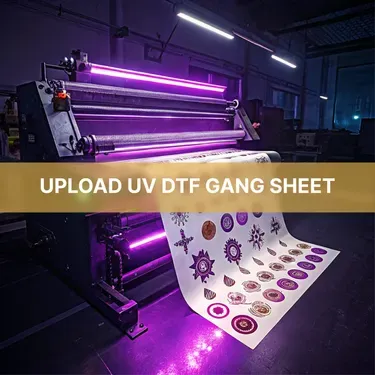UV DTF Gangheet Technology is revolutionizing the printing landscape, emerging as a frontrunner in the realm of print technology trends. By merging the capabilities of UV printing with Direct to Film methodologies, this innovative technology enhances efficiency and print quality across diverse applications. Businesses seeking sustainable printing solutions will find that UV DTF significantly mitigates environmental impact, producing vibrant, durable prints while producing fewer volatile organic compounds (VOCs). As the demand for high-quality, customizable products grows, industries ranging from textiles to promotional items are increasingly adopting this cutting-edge technology. With ongoing advancements in UV ink formulations and curing technologies, UV DTF Gangheet Technology is poised to shape the future of printing for years to come.
Introducing UV DTF Gangheet Technology, a groundbreaking printing method that integrates ultraviolet printing and Direct to Film processes to produce stunning results. This pioneering approach not only improves the quality of prints but also aligns with the latest advancements in sustainable print solutions. As industries look for versatile and efficient production methods, this technology stands out by delivering sharp, high-resolution designs on a variety of substrates. The shift towards eco-friendly printing methods is becoming increasingly important, making this technology an attractive option for businesses eager to stay ahead of print technology trends. In a world where customization and speed are vital, alternative printing techniques like UV DTF Gangheet are quickly making their mark.
Understanding the Mechanism of UV DTF Gangheet Technology
UV DTF (Direct to Film) Gangheet technology utilizes a sophisticated printing mechanism that merges the principles of UV printing with the convenience of transfer films. This method begins by printing designs on a specially treated film that features a UV-sensitive layer. Once the design is complete, the film undergoes a curing process using powerful UV lights. This curing instantly solidifies the inks, ensuring that prints are exceptionally vibrant and durable, making them ideal for intricate designs that require high resolution.
This advanced printing process not only enhances the quality of print outputs but also increases the speed of production. With the ability to achieve excellent detail and striking color reproduction, UV DTF technology stands out as a key player in the realm of printing advancements. As businesses seek to leverage cutting-edge print technology trends, understanding the operational mechanics of UV DTF is essential for those looking to integrate this innovative approach into their production capacities.
Environmental Benefits of UV DTF Printing
One of the most significant advantages of UV DTF Gangheet technology is its commitment to sustainability. Unlike traditional solvent-based inks that often release harmful volatile organic compounds (VOCs), UV inks utilized in this process are typically less harmful to the environment. This shift towards eco-friendly printing can provide businesses with a distinct advantage in markets that prioritize sustainable practices, reinforcing their brand image and attracting eco-conscious consumers.
Furthermore, the durability of UV-cured prints implies a reduced need for frequent replacements of printed materials, which translates to less waste. As environmental awareness continues to rise, adopting UV DTF technology is increasingly becoming a necessity for companies aspiring to minimize their ecological footprint while maintaining high-quality production standards.
Market Adoption Trends for UV DTF Gangheet Technology
The proliferation of UV DTF Gangheet technology in various industries signals a transformative shift in commercial printing. Sectors such as textiles, promotional products, and signage are rapidly adopting this innovative technology to meet heightened customer expectations for quality and customization. By integrating UV DTF printers into their workflows, companies can significantly enhance their productivity and expand their product offerings.
As market competition intensifies, businesses that leverage UV DTF printing are better equipped to respond to the growing demand for versatile, high-quality products. The technology’s adaptability across surfaces such as fabrics, plastics, and metals allows companies to innovate their product lines and appeal to a broader audience, making UV DTF a valuable asset in today’s dynamic market landscape.
Efficiency and Cost-Effectiveness of UV DTF Technology
In the fast-paced world of printing, efficiency is key to maintaining competitive advantage. UV DTF Gangheet technology not only streamlines printing processes but also reduces operational costs significantly. By eliminating extensive setup times and minimizing waste, businesses can achieve faster turnaround times while improving their profit margins. This aspect is particularly appealing for companies that deal with large orders or require rapid production capabilities.
Furthermore, the reduced ink consumption and low maintenance costs associated with UV DTF systems align with a business’s goal to optimize resources and enhance overall profitability. For print service providers looking to sustain growth in a challenging economic environment, the cost-effectiveness of adopting UV DTF technology offers a practical solution that balances quality with financial viability.
Versatility of UV DTF Technology
One of the standout features of UV DTF Gangheet technology is its unparalleled versatility. Unlike traditional printing technologies that may be limited by substrate type, UV DTF can effectively print on a wide array of surfaces, from textiles to hard materials such as metals and plastics. This expansive compatibility allows businesses to diversify their offerings and cater to niche markets, providing custom solutions that meet specific client needs.
Additionally, the ability to streamline production processes across various materials paves the way for innovative projects that feature unique textures and finishes. As print technology trends evolve, the versatility of UV DTF positions it as a frontrunner in enabling diverse applications, ultimately empowering businesses to explore brand-new avenues of creativity and customer engagement.
Future Innovations in UV DTF Printing Technology
Looking ahead, the future of UV DTF Gangheet technology is bright, with continuous innovations set to enhance its capabilities. As manufacturers invest in advanced UV ink formulations and improved curing technologies, the range of applications for UV DTF printing is expanding. Innovations in machine functionality, user-friendly interfaces, and enhanced integration with digital design software are streamlining the printing process, making it accessible and efficient for a wider range of users.
Additionally, as industries increasingly lean towards sustainable practices, the ongoing advancements in UV DTF technology will be pivotal in meeting these demands. The evolution of this technology not only reflects a response to market needs but also fosters greater creativity and quality in print outputs, making it a cornerstone of future printing developments.
Frequently Asked Questions
What is UV DTF Gangheet Technology and how does it change UV printing?
UV DTF Gangheet Technology revolutionizes UV printing by merging direct-to-film (DTF) methods with UV curing processes. This combination enhances print quality and offers vibrant, durable transfers suitable for diverse substrates.
How does UV DTF Gangheet Technology promote sustainable printing practices?
UV DTF Gangheet Technology utilizes UV inks that emit fewer volatile organic compounds (VOCs), promoting environmentally friendly printing. This sustainable printing approach appeals to businesses prioritizing eco-conscious practices.
What industries can benefit from UV DTF Gangheet printing advancements?
Industries such as textiles, promotional products, signage, and more can leverage UV DTF Gangheet printing advancements for high-quality, customizable products, enhancing their market competitiveness.
What are the key advantages of using UV DTF Gangheet Technology over traditional printing methods?
The main advantages of UV DTF Gangheet Technology include faster turnaround times, reduced setup costs, and the ability to print on various substrates, enabling businesses to optimize production efficiency.
What recent innovations have emerged in UV DTF Gangheet Technology?
Recent innovations in UV DTF Gangheet Technology include advancements in ink formulations and curing techniques, which improve print quality and durability across a wider range of applications.
How is UV DTF Gangheet Technology shaping the future of print technology trends?
UV DTF Gangheet Technology is shaping the future of print technology trends by emphasizing high-quality outputs, efficient production, and sustainable practices, making it a pivotal choice for modern printing solutions.
| Key Points | Details |
|---|---|
| Overview of UV DTF Gangheet Technology | Represents an innovative advancement in printing, combining UV printing benefits with transfer film processes, enhancing efficiency and quality. |
| Technology Mechanism | Involves printing designs on a UV-sensitive film that is cured with UV light, creating durable transfers ideal for complex designs. |
| Environmental Benefits | Emits fewer volatile organic compounds (VOCs) compared to solvent-based inks, appealing to eco-conscious markets. |
| Market Adoption | Gaining traction in textiles, promotional products, and signage, enhancing production capabilities and meeting high-demand for customization. |
| Efficiency and Cost-Effectiveness | Offers faster turnaround times by minimizing setup and increasing speed, thus lowering costs and improving profit margins. |
| Versatility | Can print on a variety of substrates including fabrics, plastics, and metals, allowing companies to diversify product offerings. |
| Recent Trends and Innovations | Advancements in ink formulations and automation enhance user-friendliness and printing range, improving adherence and longevity. |
| Future Prospects | Expected ongoing innovations in ink technology and machine efficiency, positioning UV DTF as a sustainable printing solution. |
Summary
UV DTF Gangheet Technology is revolutionizing the printing landscape by providing innovative, high-quality, and efficient solutions. This technology, which integrates UV printing with a Direct to Film process, not only improves print quality and detail but also offers substantial environmental benefits through reduced VOC emissions. As businesses increasingly seek sustainable and versatile printing options, UV DTF Gangheet Technology stands out as a frontrunner capable of adapting to various substrate materials. With ongoing developments in ink formulation and user-friendly machinery, the future of this technology promises to satisfy the growing demand for customizable and eco-conscious printing solutions, securing its place in the printing industry.



